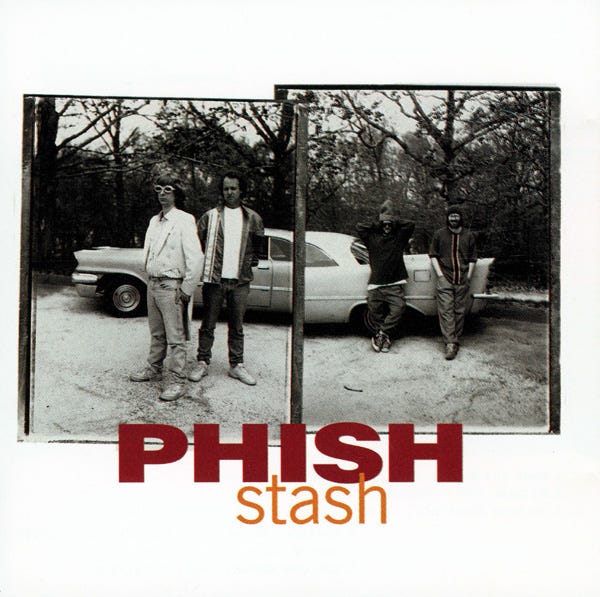SET 1: Sample in a Jar > Divided Sky, Bouncing Around the Room, The Curtain > Tweezer, Sweet Adeline, Uncle Pen, Cavern > Run Like an Antelope > Suzy Greenberg
For the band’s fourth opening set of Santana’s European tour, they were given a precious gift: an extra 20 minutes of time. Perhaps there was just no middle act, unlike the Trento (Joe Satriani) and Rome (Los Fabulosos Cadillacs) stops. Perhaps Carlos was in a charitable mood after a day of fun on the waterslides. But of all the band’s one-set warm-ups in July 1996, this one is the longest, and the one that most resembles a full half-portion of a typical Phish outing.
The setlist on this night also sort of resembles something Phish had never done and, 25 years later, probably never will do: a greatest-hits album. The obvious “what hits?” snark aside, if a Phish fan were forced to come up with a 65-minute, 10-song introduction to the band circa 1996, it would likely share quite a bit of similarities with the list above. The only real curveballs are The Curtain, used in its somewhat-common Fall 95 role as a prelude to Tweezer, and Uncle Pen, a cover that nevertheless stands in aptly for the band’s jamgrass dimension. Apart from that, you get a sampler of some of the band’s biggest and most accessible songs, with a good balance of ornate composition, improv flexibility, and catchy choruses.
But wait — I sort of lied. Because Phish in 1996 did release a compilation that, while not marketed as a greatest hits collection, was the next closest thing. Stash, a European-only release in the Spring of ‘96, was intended as promotion for this July visit, and some of the Phish headliner shows to come used its austere cover art for the posters. The CD chose 8 tracks from Phish’s first four studio albums and 3 from A Live One, and given the inherent difficulties in providing a single-disc survey of such an amorphous band, it does a pretty okay job.
Sure, there’s a weird fixation on ballads, including both “If I Could” and “Fast Enough For You,” basically the band’s only two recorded slow songs at this point. But leading with Disease is smart — possibly even smarter than the band itself, which had mostly forgotten the song existed for the last year. Including YEM and Melt meant it wasn’t just sanitized down to the most direct material, Mule and Gumbo represented the band’s weirdo genre play, and drafting the ALO Stash, making it the title track even, was an ample teaser of the band’s live mastery.
It’s notable then that the sorta-greatest-hits tracklists of Stash and 7/7/96 only share two songs: Sample and Bouncin, generally the two gimme singles for any reasonable Intro to Phish effort. There are some stylistic-sibling swaps that make sense, such as Divided Sky for YEM, Uncle Pen for Mule, Tweezer for Stash, and Antelope for Maze. There’s no ballad replacement, but there is Sweet Adeline, which fills the worthwhile role of a barbershop song in a live “greatest hits” set (and as Trey lectures, leads a mid-set double pack of “traditional American songs.”)
That’s testament to the depth of the Phish catalog at this stage of their career...but also maybe a handicap for a band relegated to opening act duty. Most bands on unfamiliar turf wouldn’t think twice about putting together a “greatest hits” set and playing it night in and night out; the majority of fans in attendance didn’t buy a ticket to see them, so why not put their best foot forward and win over some converts? But the rotating setlist rules of Phish were so deeply ingrained by 1996, it would be pure heresy if they repeated a single song from night to night, never mind an entire set, and never mind if only the few dozen Phish fans following them around Europe would notice.
If the goal of the 1996 Europe Tour was really to win over new fans abroad, Phish might have considered loosening those setlist standards a little bit and fine-tuning one killer set with a few nightly modifications. But I’m not sure that’s what the point of this trip was...if there even was a point beyond “American bands go to Europe once they’ve achieved a certain success back at home.” In 1997 and 1998, Europe would be a laboratory out of the spotlight for Phish to craft its next move. By contrast, 1996 feels like a dry run, establishing an outpost without going either full commercial or experimental. Like most greatest hits albums, it’s an easy placeholder buying time between riskier artistic steps.





